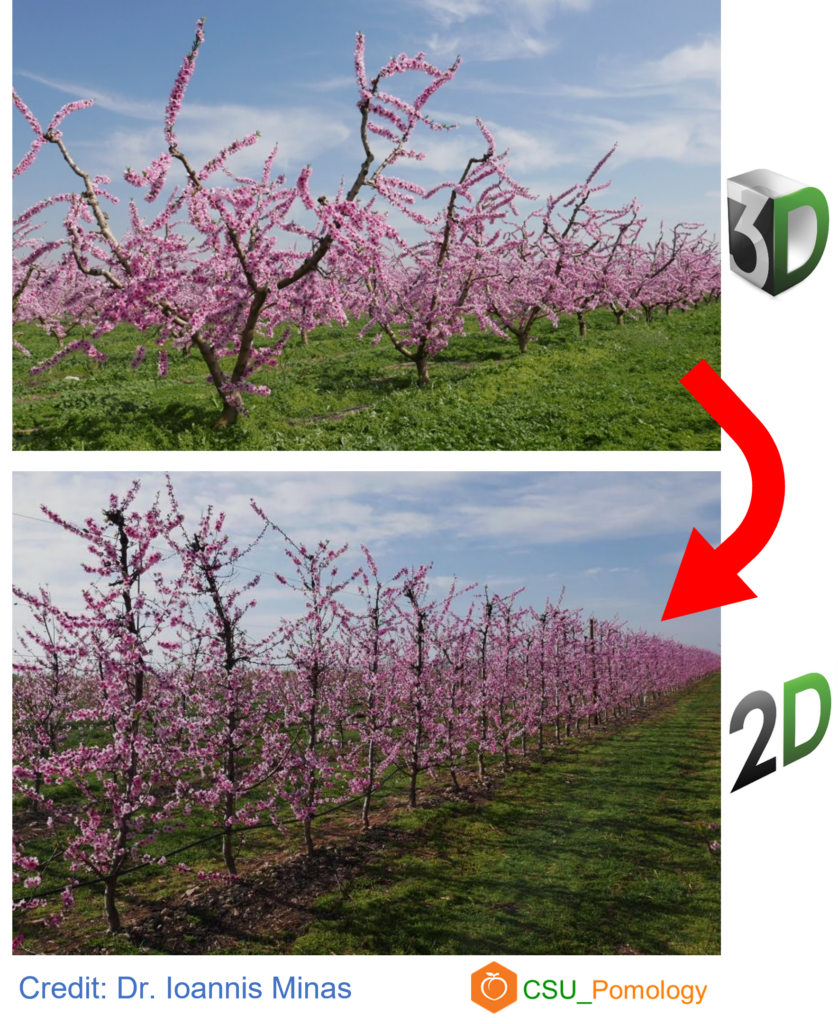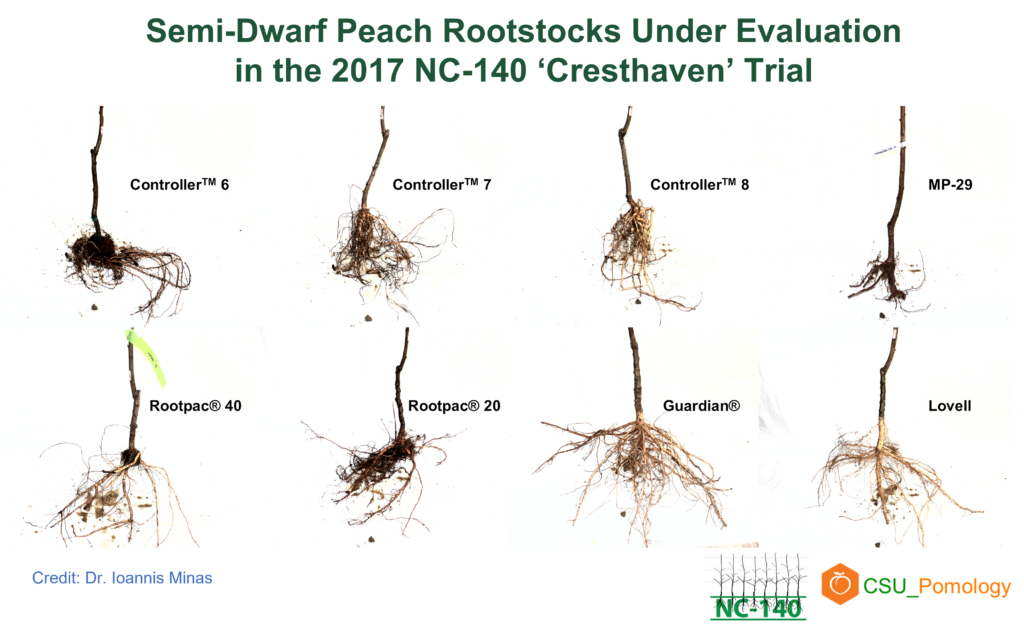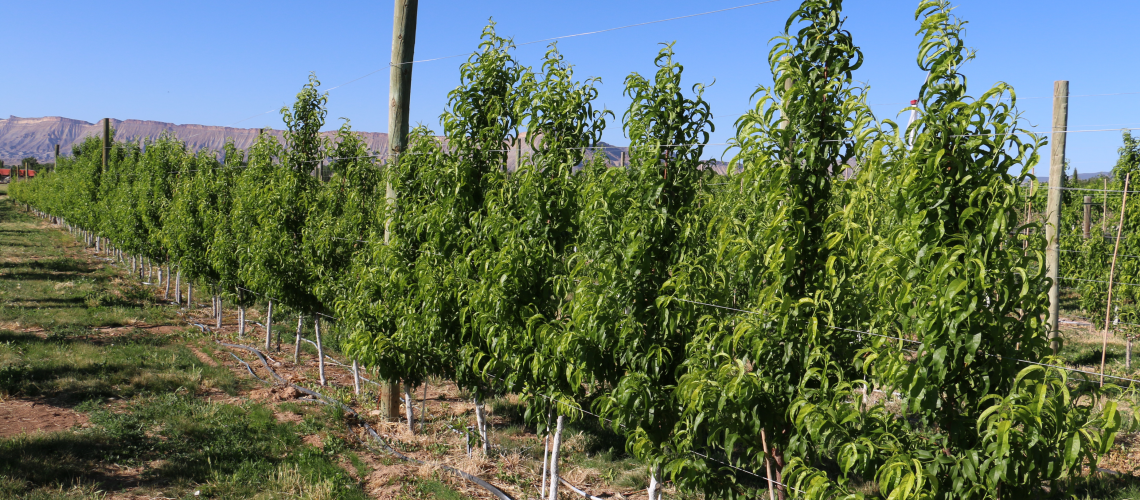Guest Post by Brendon Anthony, 2021-2022 Sustainability Leadership Fellow, and Postdoctoral Fellow in the Department of Horticulture and Landscape Architecture at Colorado State University
Recent sustainable agriculture guidelines are encouraging farmers to be able to grow more food, on less land, with less resources, and with a net zero (or even positive) impact on the environment (USDA-NIFA, 2018). With an exponentially growing population and an immediate climate crisis, food production goals and standards must satisfy people and the planet. However, this is obviously much easier said than done, especially if the goal is to also provide nutritionally dense food for human consumption and not just agronomic crops like corn, soy, and grain.
Specialty crop production is an extremely important agricultural sector as it provides us the fruits and vegetables that we crave and nutritionally require. One specialty crop in Colorado that locals anticipate and desire each year is peaches. In a small region on the Western Slope of Colorado exists enough frost-free days to grow and produce tree fruit, such as apples, cherries and peaches. However, none is more fantasized over than the region’s named, “Palisade Peach.” The “brand” is iconic, notable by Coloradoans, and boasts the number one price per pound (i.e., farmgate price) in the nation (USDA-NASS, 2019). This is due to the extremely high quality of fruit that Western Colorado can produce, given its ideal climate (warm days, cool nights in the summer) and access to local markets, which allows the picking and sales of peaches at a more “tree ripe” stage (i.e., more ripe = improved quality) (Anthony and Minas, 2021). This price premium on high-quality peaches enables a lucrative market for growers on the Western Slope. But, with a diminishing water supply, increased urban sprawl in the region, reduced labor availability, and more climate change-induced extreme weather events (i.e., Fall freezes and Spring frosts), the industry is pressured to produce more with less. In other words, the United States’ “best” peach might be in jeopardy.
High Density vs. Low Density Orchards
Enter high-density orchard plantings as a solution. High-density plantings (HDPs for short) are an orchard design innovation that apple and cherry have crossed the divide on, with peaches beginning to embark on this journey. This journey entails the transition from low-density plantings (LDPs) to HDPs. So, what is the difference between these two?
First, imagine a traditional orchard, where trees are trained into a “vase-like” shape, with limbs emanating from the trunk in a circumferential pattern, extending high into the sky and across the rows. You need a big ladder to reach the fruit growing at the top and large loppers to prune the big branches each year. Given the size of the trees, they must be planted further apart (10 – 12 ft), as they create a large 3D, spherical architecture that requires space to grow and access sunlight. As a result, the tree density cannot exceed 500 trees per acre and so are defined as LDPs (Anthony and Minas, 2021).
Now, imagine an orchard, less like the idyllic heritage style I have just described, but more like a corn field. With trees planted closer together (3 – 5 ft), in tightly knit rows and not exceeding eight feet in height, everything can be pruned, picked, and managed from the ground (i.e., pedestrian orchard). These trees are 2D or planar in nature, creating a uniform “fruiting wall” (via training system selection) that can be mechanically pruned like a knife cutting through a loaf of bread, or robotically picked with cameras that can detect red, ripe fruit that can be pulled or vacuumed off the tree (Figure 1). This is the orchard of the “future” for peaches and has quite already become the orchard of the “now” for apples. These HDPs can facilitate more than 2,500 trees per acre, yielding an exponentially larger amount of fruit per unit area of production (i.e., production efficiency) (Anthony and Minas, 2021). HDP orchards boast higher yields and higher quality, but there is one piece that facilitates this transformation.

Dwarfing Rootstocks, the Key to the Orchard Design Puzzle
The key that unlocks the transition from 3D, LDPs to 2D, HDPs, are dwarfing rootstocks. These root systems are bred to control the size (or vigor) of the tree, amongst other characteristics such as: disease resistance, mineral acquisition, water use efficiency and graft compatibility (Anthony and Musacchi, 2021). A modern fruit tree consists of two parts: a rootstock, the root system that sits below the orchard floor, and the scion (or cultivar), which is grafted onto the rootstock and grows above ground, producing the fruit that is desired by the consumer (e.g., ‘Gala’ apple, ‘Rainier’ cherry, ‘Redhaven’ peach). These “dwarfing” rootstocks were initially bred for apple in the early 20th century (Anthony and Musacchi, 2021). This innovation has now begun to spread across tree species, with modern breeding efforts across the globe trying to facilitate this transition in every fruit imaginable, from tropical to temperate environments. These orchard designs improve the amount of crop produced per unit area, which makes them appealing for farmers. The trees are smaller, easier to manage, and are more fully exposed to sunlight, generating healthier trees and higher-quality fruit. These genetic (rootstock selection) and horticultural manipulations (training and pruning) allow for improved orchard sustainability by controlling for vigor without chemical applications and by reducing labor costs (Lauri et al., 2008). Until recently, these dwarfing rootstocks were not available for peach, thus limiting the orchard design innovation that is required for HDPs. Dwarfing peach rootstocks are now becoming more commercially available, with Colorado State University leading the charge for new peach rootstock evaluation on a national scale (e.g., NC-140) (Figure 2; Minas et al., 2022).

High Intensity or High Efficiency?
HDPs have been under scrutiny for potentially requiring additional inputs than traditional orchards, given the increased number of trees. However, when evaluated on an efficiency basis, HDPs are more efficient in their land, water, light and labor use (Robinson, 2004). In other words, HDPs can produce “more crop per drop.” Planar HDP systems have demonstrated the ability to increase production and profits, while reducing labor costs and inputs, because of their increased light utilization, photosynthetic efficiency, and simplified canopies (DeJong et al., 2006). Given the planar architecture of fruiting walls, these orchards are hypothesized to reduce input use, as foliar applications, for example, can result in improved coverage of the canopies and be more effective. Thus, enhanced coverage may require less spray applications to manage pests and/or improve foliar nutrition. Additionally, given the increased densities, these modern orchards have shown promising data that they are able to sequester more carbon in the soils than traditional plantings (Sofo et al., 2005). In respect to social sustainability, labor conditions can be improved with these simplified, pedestrian canopies, mitigating ladder accidents, and reducing the time needed for laborious tasks like pruning and harvesting. Although much more research is required to determine the environmental impacts/benefits of these HDP systems when compared to traditional LDPs, previous studies indicate promising results that these increased density orchards may enhance areas such as resource use efficiency, pollinator attraction, habitat for biodiversity, pesticide application efficacy and carbon sequestration (i.e., increased soil organic matter) (Simon et al., 2011; Sofo et al., 2005).
As the agricultural industry seeks to achieve sustainable production goals in the 21st century, producers must balance economic, environmental, and social needs. Profitability and efficiency must be valued greater than sheer productivity alone. Biology (e.g., soil health) must be relied on more than chemistry (e.g., synthetic inputs) alone, as we seek to promote productive agroecosystems that are rich in biodiversity, resilient to climate change and utilizing limited resources efficiently. High-density orchard systems appear to be a solution for the increasing production demands of a growing population, paired with a deteriorating environment that must be stewarded and relied on much more efficiently.
References:
Anthony, B.M. and Minas, I.S., 2021. Optimizing Peach Tree Canopy Architecture for Efficient Light Use, Increased Productivity and Improved Fruit Quality. Agronomy, 11(10), p.1961.
Anthony, B. and Musacchi, S. 2021. Dwarfing mechanisms and rootstock-scion relationships in apple. Italus Hortus, 28(2), pp. 22-36.
DeJong, T.M., 2006, August. Physiological and technological barriers to increasing production efficiency and economic sustainability of peach production systems in California. In XXVII International Horticultural Congress-IHC2006: International Symposium on Enhancing Economic and Environmental 772 (pp. 415-422).
Lauri, P.E., Costes, E., Regnard, J.L., Brun, L., Simon, S., Monney, P. and Sinoquet, H., 2008, February. Does knowledge on fruit tree architecture and its implications for orchard management improve horticultural sustainability? An overview of recent advances in the apple. In I International Symposium on Horticulture in Europe 817 (pp. 243-250).
Minas, I.S., Reighard, G.L., Brent Black, B., Cline, J.A., Chavez, D.J., Coneva, E., Lang, G., Parker, M., Robinson, T., Schupp, J., Francescato, P., Jaume Lordan, J., Tom Beckman, T., Shane, W., Sterle, D., Pieper, J., Cathy Bakker, C., Clark, B., Ouellette, D., Swain, A., Winzeler, H.E. 2022. Establishment performance of the 2017 NC-140 semi-dwarf peach rootstock trial across 10 sites in North America. Acta Horticulturae in press.
Robinson, T.L., 2004, June. Recent advances and future directions in orchard planting systems. In VIII International Symposium on Canopy, Rootstocks and Environmental Physiology in Orchard Systems 732 (pp. 367-381).
Simon, S., Bouvier, J.C., Debras, J.F. and Sauphanor, B., 2011. Biodiversity and pest management in orchard systems. Sustainable Agriculture Volume 2, pp.693-709.
Sofo, A., Nuzzo, V., Palese, A.M., Xiloyannis, C., Celano, G., Zukowskyj, P. and Dichio, B., 2005. Net CO2 storage in Mediterranean olive and peach orchards. Scientia horticulturae, 107(1), pp.17-24.
USDA-National Agricultural Statistics Service. 2019. Available online: http://www.nass.usda.gov/ (accessed on 31 July 2021).
USDA-National Institute of Food and Agriculture. 2018. Sustainable Agriculture Program. Available online: https://nifa.usda.gov/program/sustainable-agriculture-program (accessed on 5 January 2022).






